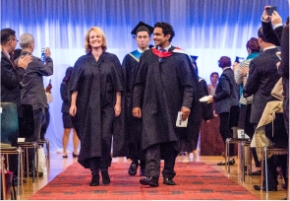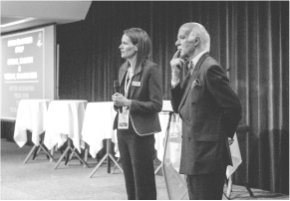- About
- Programs
- Innovation & Research
- Campus Life
- Career Services
- Admissions
- News & Events
- Alumni
From Legacy to Leadership: Industry Transformation Examples
Explore key industry transformation examples and what sparked their change. Learn from these shifts. See how disruption creates opportunity.
Key Takeaways
- Industry transformation happens when factors like technology, regulation, consumer expectations, global events, or sustainability pressures push businesses to rethink how they operate.
- Technology has become the main driver of industry change, reshaping operations, business models, and customer expectations across every sector.
- Industry change is inevitable, and success depends on leaders who pair deep expertise with the adaptability to embrace new ideas and technologies.
The 18th century's Industrial Revolution set humanity on its first great surge of change, as steam and machinery completely altered the way people lived and worked. Before it, daily life was tied to manual labor and local production; afterwards, factories, railways, and mass manufacturing reshaped economies and societies. It was humanity's first major leap into systematic progress.
In a different sphere, our namesake César Ritz transformed hospitality at the turn of the 20th century. He redefined what hotels could be through new approaches to staff training, and the creation of an international hospitality brand. By putting guest experience at the center, he set standards that continue to shape the industry today.
Modern industry transformation examples show us that change is inevitable. Companies that recognize the signs early can position themselves as leaders and secure long-term relevance, while those that resist often find themselves struggling to survive.
What Drives Industry Transformation?
Industry transformation never happens in a vacuum. Entire sectors don't simply change on their own; they shift when certain forces act as catalysts and push businesses to rethink how they operate and deliver value.
These catalysts can come from external pressures or internal innovation. Some of the most common include:
- Technological innovation: new tools and systems change how businesses operate and how customers interact with them.
- Regulatory changes: updated laws or standards in areas like safety, labor, or data management push industries to adapt.
- Consumer behavior shifts: evolving expectations around convenience, personalization, and value continually reshape demand.
- Global crises: pandemics, wars, or economic downturns can disrupt industries overnight and force rapid adjustment.
- Environmental pressures and sustainability demands: climate challenges and rising preference for responsible practices influence how businesses design their strategies.
These drivers usually don’t act in isolation. The biggest industry changes happen when several factors overlap, pushing businesses to adapt much faster than they would if only one force were at play.
Technology-Driven Transformations
Technology has reshaped nearly every part of daily life, and industries are no exception. Digital innovation has become the leading catalyst for change, with 81% of business leaders calling investments in digital transformation essential for success.
While every sector has felt this impact, some have seen particularly striking shifts that reveal how deeply technology can change operations, business models, and customer expectations.
Media and entertainment
Few industries demonstrate this shift as clearly as entertainment. The introduction of platforms like Netflix completely altered how people watch movies; it rewrote the rules of production, distribution, and consumption.
Traditional broadcasters once relied on fixed schedules and advertising revenue, but the rise of streaming introduced subscription models, original content, and on-demand viewing. The ripple effects spread quickly: Disney launched Disney+, HBO rolled out HBO Max, and even Apple stepped into content creation with Apple TV+.
This transformation also changed what gets produced. "Binge-worthy" series designed for streaming dominate production pipelines, while international content now reaches global audiences without geographic barriers.
Your Leadership Journey Starts Here
Master the art of hospitality management
Retail
Retail's digital shift is often summed up in one word: Amazon. Starting as an online bookstore, Amazon fundamentally altered customer expectations around choice, delivery speed, and convenience. In response, traditional retailers had to adopt omnichannel strategies, building seamless experiences across in-store and online platforms.
In retail, digital transformation has taken many forms, from POS systems and mobile shopping apps to supply chain software and self-checkout solutions. Reflecting this shift, Gartner reports that 57% of retailers plan to increase their spending on new technology.
Automotive
Tesla redefined what a car company could be, turning vehicles into connected platforms. Over-the-air updates, direct-to-consumer sales, and autonomous driving research have pushed traditional manufacturers to follow. Giants like GM, Ford, and Volkswagen now pour billions into electric vehicles, charging infrastructure, and new digital services.
By 2030, on-demand mobility and data-driven services are projected to generate about €1.4 trillion (≈$1.5 trillion) in additional revenue—roughly a 30 % increase compared with the traditional €4.8 trillion ($5.2 trillion) market tied to car sales in 2015. Meeting this shift requires new expertise from engineers and across the entire supply chain.
Hospitality
In hospitality, digital transformation has transformed both the guest experience and back-end operations. Mobile check-ins, smart room controls, and AI chatbots streamline service while freeing staff to focus on personal touches. At the same time, property management systems, CRMs, and revenue optimization tools are modernizing the behind-the-scenes.
Yet the challenge is integration. A fragmented approach risks creating disjointed experiences. True transformation means linking tools so stays feel seamless—from booking to check-out. 56% of hospitality leaders admit there's a gap between their current systems and what's needed to compete effectively.
This is why at César Ritz Colleges, we focus on preparing students for this evolving reality through the philosophy of Rethink. Refine. Realize. Our students are encouraged to challenge outdated models, refine their strategies through mentorship and feedback, and apply solutions in real-world environments. As technologies in hospitality keep advancing, this mindset equips future leaders to adapt while never losing sight of service.
Customer-Centric Transformations
Some of the most successful industry transformation examples emerge when companies recognize fundamental shifts in customer values and expectations. These transformations often create entirely new market categories.
Food industry
Plant-based alternatives perfectly illustrate how changing consumer priorities—around health, environmental impact, and animal welfare—have spurred technological breakthroughs. Modern companies such as Beyond Meat and Impossible Foods have invested heavily in R&D (Research and Development) to make substitutes that closely replicate the sensory experience of eating meat.
Impossible Foods, for instance, uses a genetically engineered strain of yeast to produce soy leghemoglobin, the molecule that allows its products to "bleed" and carry a meaty flavor. Beyond Meat, by contrast, relies on a food extrusion machine, which manipulates heat and pressure to align plant proteins into fibrous, muscle-like textures.
This technological focus extends well beyond what's on the plate. Transparent supply chains now allow consumers to trace the origin of their food, while blockchain-backed sourcing systems guarantee authenticity.
Sustainable packaging—from compostable wraps to edible films—directly responds to growing concerns about waste. Clear labeling of ingredients, sourcing practices, and environmental impact has become a differentiator for brands competing in the plant-based and wider food market.
All these innovations show how technology is transforming food production to align with consumer expectations of health, ethics, and sustainability.
Fashion
Fashion faces a parallel shift. Fast fashion's environmental and social costs have driven consumers to demand sustainability and transparency. In response, brands are channeling more resources into technology: investments in fashion tech are projected to rise to between 3% and 3.5% of revenue, up from 1.6%–1.7% in 2021.
Companies like Patagonia have built reputations around durability and responsible sourcing, while even luxury brands now emphasize craftsmanship and long-term value. At the same time, new business models—clothing rental, resale platforms, and made-to-order production—combine consumer desire for variety with a push to reduce waste.
Technology reinforces these shifts. Online fashion is exploding, with the market projected to grow to €4.4 billion ($4.8 billion) by 2031 at a compound annual growth rate (CAGR) of 26.4%. Digital platforms enable resale marketplaces, AI-driven personalization for online shopping, and blockchain solutions for verifying supply chain integrity.
This way, consumer expectations for sustainability and authenticity are driving brands to integrate advanced tech into every part of their operations.
Crisis-Induced Industry Shifts
Industry transformation rarely unfolds on a neat timeline. Often, external shocks push sectors to adopt changes far faster than they otherwise would. The COVID-19 pandemic serves as a striking case, accelerating shifts in both education and healthcare that continue to influence how these industries function today.
Education
When classrooms shut down, digital learning platforms became the lifeline of education. What began as emergency remote teaching quickly evolved into a deeper rethinking of delivery methods. Institutions didn't stop at video calls—they invested in learning management systems, virtual reality classrooms, and AI-powered tutoring to sustain quality and engagement.
The results are visible in how quickly educational technology grew. The sector, valued at about €150 billion (≈$163.49 billion) in 2024, is projected to reach €320 billion (≈$348.41 billion) by 2030, growing at a CAGR of 13.3%. This expansion is directly mirrored in the classroom as surveys show that 92% of students now use some form of AI in their studies, alongside other technology.
What began as a response to the crisis has evolved into a lasting expectation: flexibility, accessibility, and technology-driven learning are now central to how education operates.
Healthcare
Healthcare experienced a similar acceleration. Regulations were loosened almost overnight to allow broad use of telemedicine, shifting how care was delivered. Patients, once hesitant about virtual consultations, quickly became comfortable using them for routine care, chronic disease management, and even mental health services.
The numbers highlight the scale of this change. By 2021, 96% of hospitals and 78% of office-based physicians had adopted certified electronic health records—up from just 34% and 28% in 2011. Health systems themselves increasingly view digital tools as more than cost-saving measures: 92% of providers now cite improving patient experience as their top goal for digital investment.
Usage data shows how telehealth diversified during the pandemic. In France, by 2024, 90% of citizens had used telemedicine, and 74% believed it improved integrated care and monitoring. Studies of cancer care also showed that telehealth enhanced access and simplified processes, particularly in early palliative care.
This acceleration created lasting change. Telemedicine is no longer viewed as a temporary substitute but as an embedded part of healthcare systems worldwide. It has broadened access, cut costs in some areas, and encouraged a consumer-centered approach that designs care delivery around patient expectations of convenience and trust.
Legacy Industry Reinventions
Even some of the most established industries are reinventing themselves. Technology is pushing traditional sectors to adapt to modern realities while maintaining their core strengths.
Banking
Mobile-first services, instant transfers, and AI-powered financial tools have transformed the banking industry. It's a shift that aligns with customer expectations, as 77% of consumers now prefer to manage their bank accounts through a mobile app or computer, and 83% say digital innovations have made banking more accessible.
Traditional banks have invested heavily in digital platforms while leaning on the trust and regulatory expertise they've built over decades. Some launched their own fintech divisions, while others formed partnerships or acquired tech companies to accelerate progress.
Energy
Traditional oil and gas companies are also expanding their strategies. They are moving past their historic reliance on fossil fuels to invest in renewables, energy storage, and carbon capture.
Oil and gas companies are directing billions into renewable energy, storage solutions, and carbon capture technology. Projections suggest that they will increase renewable investments by around 25% annually over the next decade, marking a significant reallocation of capital.
Today, firms like BP and Shell describe themselves as energy companies rather than oil companies, signaling how much strategy has shifted. Currently, most large players dedicate 5–10% of their total capital expenditures to renewable projects, with that share expected to rise as demand for sustainability grows.
The shift also brings new alliances with technology companies, investments in electric vehicle charging networks, and an urgent need for fresh skills across their workforces.
Learn to Lead Industry Transformations
Change is not something to fear, nor is it something you can avoid. Industries shift whether we like it or not, and the choice lies in how we respond: adapt and seize the opportunities, or resist and face decline.
Transformational leadership matters most in these cases. The most effective leaders in transformed industries are the ones who can balance two qualities: deep knowledge of their core business and the adaptability to embrace new ideas, tools, and technologies.
Developing such leadership qualities requires structured learning, practical exposure, and mentorship from those who have already navigated transformation themselves. At César Ritz Colleges, the MS in Leadership program is designed with exactly this in mind. Students learn how to manage people, strategies, and innovations in a way that anticipates change as well as uses it as a driver for growth.
Change is inevitable. Success is not. The difference lies in how you lead—and with us, you learn to lead to succeed.
Frequently Asked Questions
Is digital transformation the same as industry transformation?
Digital transformation is a type of industry transformation that focuses specifically on technology adoption. Industry transformation is broader, encompassing changes driven by customer behavior, regulations, sustainability requirements, and other factors beyond just digital technology.
How can small businesses keep up with industry transformation?
Small businesses can keep up with industry transformations by adopting new technologies quickly, focusing on niche customer needs, and forming strategic partnerships with larger companies or technology providers.
Are you wondering where to start your dream hospitality career? Look no further than a bachelor’s degree at César Ritz Colleges Switzerland.





















